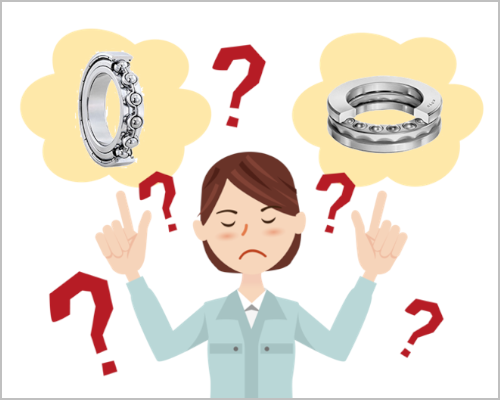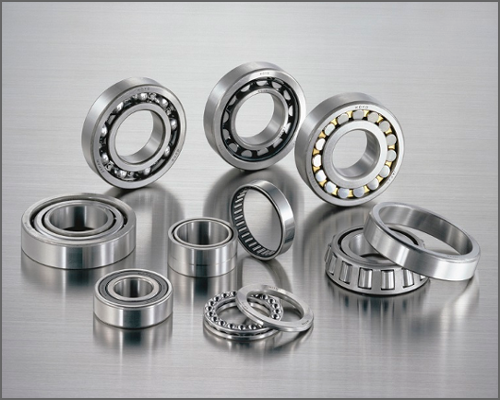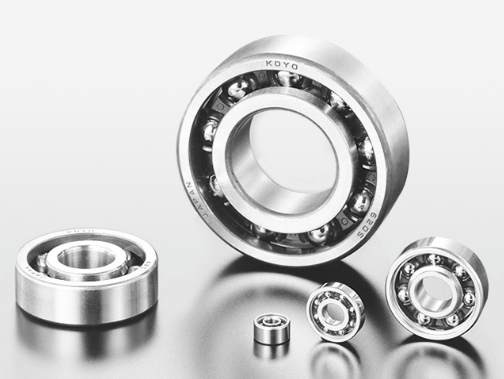Bearing Trivia
How to Select the Right Bearing (Part 3): Bearing dimensions and service life
- #2 How to Select the Right Bearing
In Part 2, we explained how to decide on the bearing arrangement.
How to Select the Right Bearing (Part 2): How to decide the bearing arrangement
In Part 3, we will explain the dimensions and service life of a bearing as measures for whether the bearing type you chose was appropriate.

When selecting a bearing, we need to determine the appropriate dimensions of the bearing so that it can rotate stably inside the machine. What kind of things do we need to look out for when doing this?
In Part 3, we will elaborate on the following two points you need to be aware of when deciding the size of your bearing needs to be.
- The bearing should have sufficient service life
- The bearing should be able to rotate smoothly
Table 1: Bearing selection checklist
| Order | Examination item | Major points to confirm |
|---|---|---|
| ① | Bearing type | What magnitude and direction of load do you need? Will it fit in the installation space? |
| ② | Bearing arrangement | Are you using two (or more) bearings on a single shaft? |
| ③ | Bearing dimensions and service life | Do the dimensions and service life satisfy your needs? <This is the focus of Part 3> |
| ④ | Bearing limiting speed, running accuracy, fits and internal clearance | Does it have the necessary running accuracy and rigidity for the machine? Does it have the fits and internal clearance to satisfy its service life? |
| ⑤ | Bearing preload and rigidity | Does it have the necessary rigidity for the machine? |
| ⑥ | Bearing lubrication | Can the bearing rotate stably over a long period of time? |
| ⑦ | Components around the bearing | What bearing surrounding structure/assembly are you looking for? |
| ⑧ | Bearing mounting and dismounting | Will it facilitate maintenance/inspection of the machine? |
1. Bearing service life
1) The necessary bearing service life
Setting the service life of a bearing to be longer than necessary is not economical, and so it is important to select a bearing with a service life that is appropriate for the machine application and usage criteria.
You can see in Table 2 the recommended service life of bearings in accordance with the application, as empirically determined.
Table 2: Recommedned bearing service life (reference)
| Operating condition | Application | Required service life (h) |
|---|---|---|
| Short or intermittent operation | Household electric appliance, electric tools, agricultural equipment, heavy cargo hoisting equipment | 4,000h ~ 8,000h |
| Not extended duration, but stable operation required | Household air conditioner motors, construction equipment, conveyors, elevators | 8,000h ~ 12,000h |
Reference: The recommended service life of bearings
2) What is bearing service life?
So just what determines a bearing's service life?
When the bearing that supports the load rotates, the load is repeatedly applied to the raceway surfaces of the inner and outer rings each time rolling elements (balls or rollers) pass (see Figure 1).

Fig. 1: Repeated loads applied to bearings
Due to this repeated load, high pressure is generated on the raceway surfaces of the inner and outer rings that are in contact with the rolling surfaces of the rolling elements. Consequently, material flakes from the surfaces of inner and outer rings or rolling elements by fatigue arising from repeated contact stress (see Figure 2).
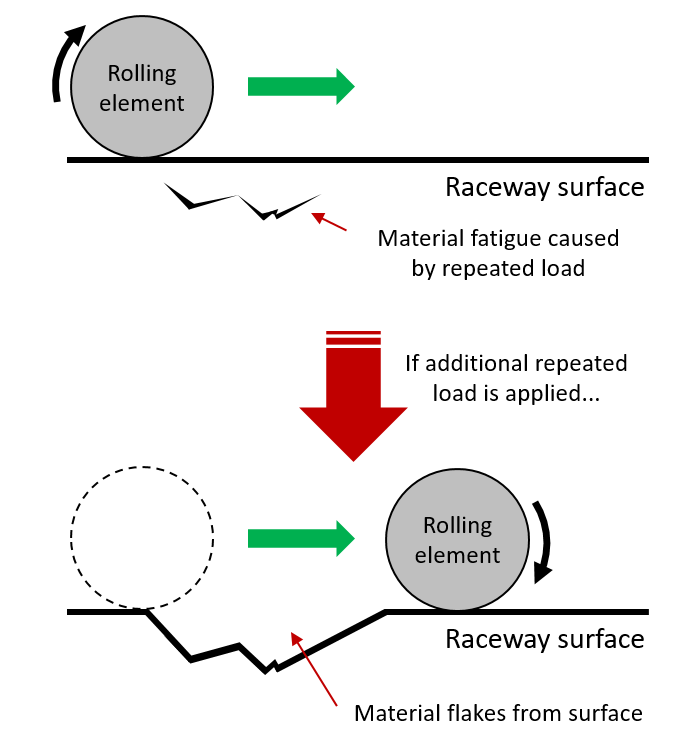
Fig. 2: Fatigue on the raceway surface

Fig. 3: Flaking of material due to fatigue on the rolling element
(inner ring raceway surface of a tapered roller bearing)
The total number of bearing rotations until flaking occurs is regarded as the bearing "fatigue service life.", and this can be predicted.
Note that since the fatigue life of bearings varies, when a group of identical bearings are rotated under the same conditions, the total number of revolutions until 90% of the bearings are left without flaking is defined as the "basic rating life."
3) Confirm the bearing service life
When designing a machine, select a bearing with a basic rating life that does not cause rolling fatigue within the required time.
In order to predict the basic rating life, we can use the following two loads.
Basic dynamic load rating
A bearing capacity against fatigue is called its "basic dynamic load rating."
This is the load at which fatigue appears after 1 million revolutions of the bearing.
The specifications tables in the Ball & Roller Bearings Catalog show the basic dynamic load rating for each bearing type and set of dimensions (see Table 3).
Table 3: Basic dynamic load rating of a bearing
| Name of basic load rating | Bearing type | |
|---|---|---|
| Basic dynamic radial load rating | Cr | Radial bearing |
| Basic dynamic axial load rating | Ca | Thrust bearing |
Dynamic equivalent load
Bearings used in machines are subject to various magnitudes of loads from various directions. But these loads cannot be directly compared to basic dynamic load ratings. For this reason, when examining the service life of a bearing, obtain a load that will have the same service life as the actual load and rotational speed.
This load is called the "dynamic equivalent load."
Reference: How to obtain the load applied to a bearing
Reference: How to obtain the dynamic equivalent load
Use the "basic dynamic load rating" and the "dynamic equivalent load" to find the bearing basic rating life (see Figure 4).
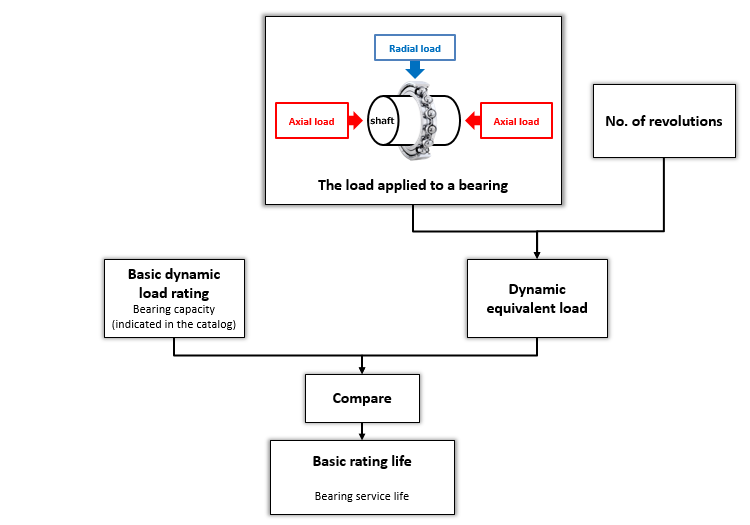
Fig. 4: Bearing service life
Check whether the service life of the selected bearing satisfies the required service life (is insufficient or much too long). If it is not satisfactory, reexamine the dimensions of the bearing.
2. Confirm that the bearing rotates smoothly
When extremely heavy load is applied to a bearing that is not rotating, or that is rotating at a low speed, an indentation (permanent deformation) occurs in the contact area between the rolling element and the raceway surface of the inner and outer rings. This dent grows with the increasing load and prevents smooth rotation of the bearing above certain limits (see Figures 5 and 6).
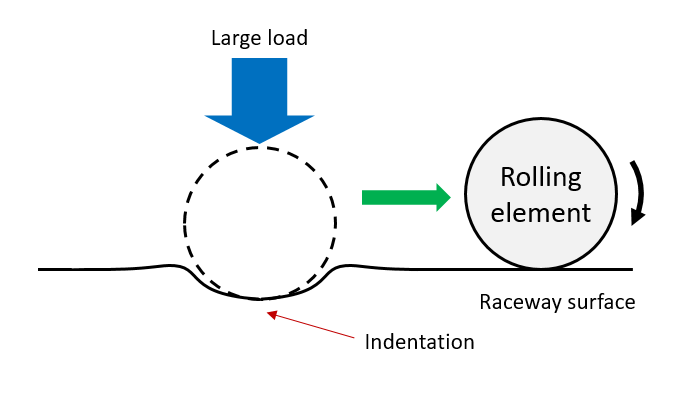
Fig. 5: Developing of an indentation
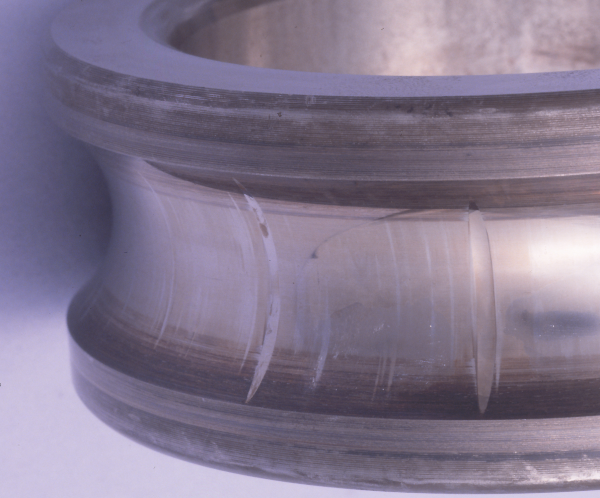
Fig. 6: An indentation caused by extremely heavy load (inner ring raceway surface of a ball bearing)
1) Basic static load rating
In order to prevent a dent from growing larger and impeding smooth rotation, limits are set on the loads bearings can be subject to.
This limit load is called the "basic static load rating" (see Figure 7).
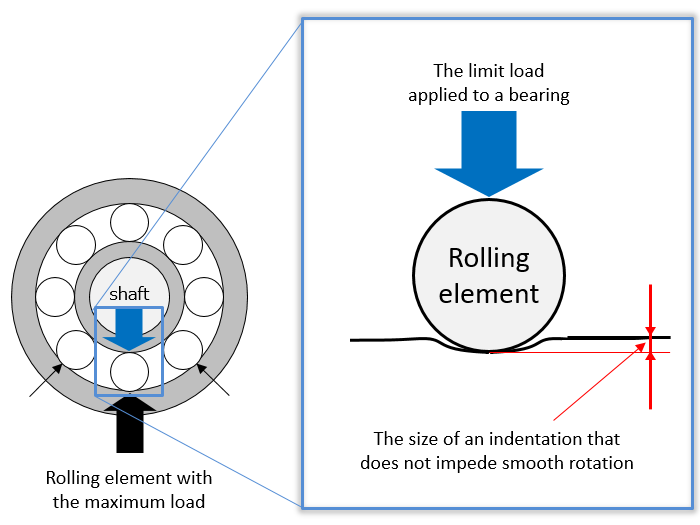
Fig. 7: An indentation that doesn't impede smooth rotation
The specifications tables in our bearing catalog show the basic static load rating for each bearing type and set of dimensions (see Table 4).
Table 4: Basic static load rating of a bearing
| Name of basic load rating | Bearing type | |
|---|---|---|
| Basic static radial load rating | C0r | Radial bearing |
| Basic static axial load rating | C0a | Thrust bearing |
2) Static equivalent load
Bearings used in machines are subject to various magnitudes of loads from various directions. But these loads cannot be directly compared to basic static load ratings. For this reason, we must look for the load that achieves the same contact as that which occurs between the rolling element (that actually receives the maximum load) and the contact surface (between the inner ring and outer ring).
This load is called the "static equivalent load."
Reference: How to obtain the static equivalent load
Compare the basic static load rating and static equivalent load to confirm the indentation-based usage limit of the bearing.
Reference: Bearing usage limits
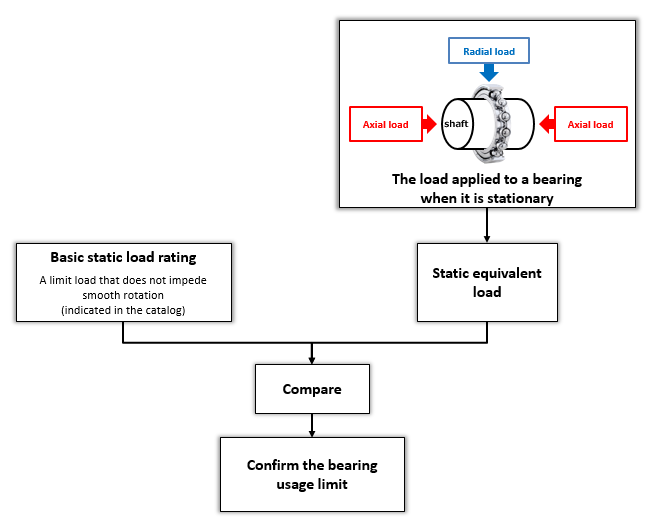
Fig. 8: Confirm that the bearing rotates smoothly
If it does not satisfy the usage limit of the selected bearing, reexamine the dimensions of the bearing.
JTEKT actually offers a service to calculate the service life of a bearing, so why not take advantage of it?
Reference: Technical Calculation Tool
Examples of basic dynamic load rating and basic static load rating of bearings in the catalog
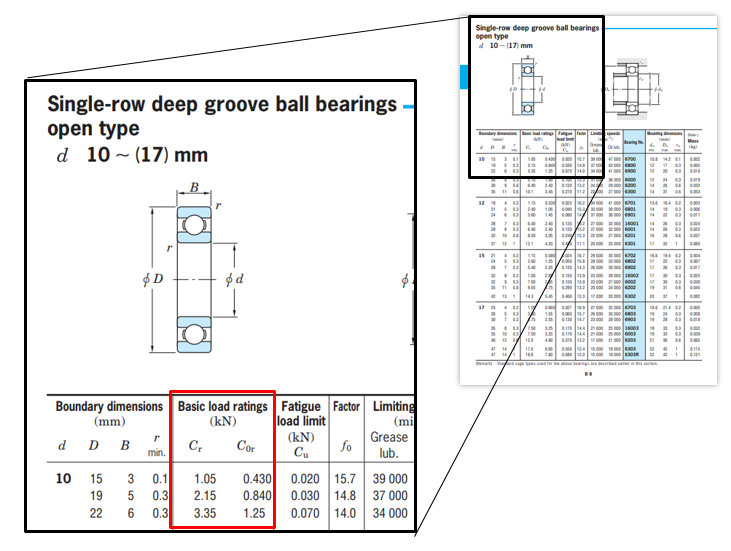
Fig. 9: Radial bearings
Reference: Ball & Roller Bearings Catalog deep groove ball bearing specifications table
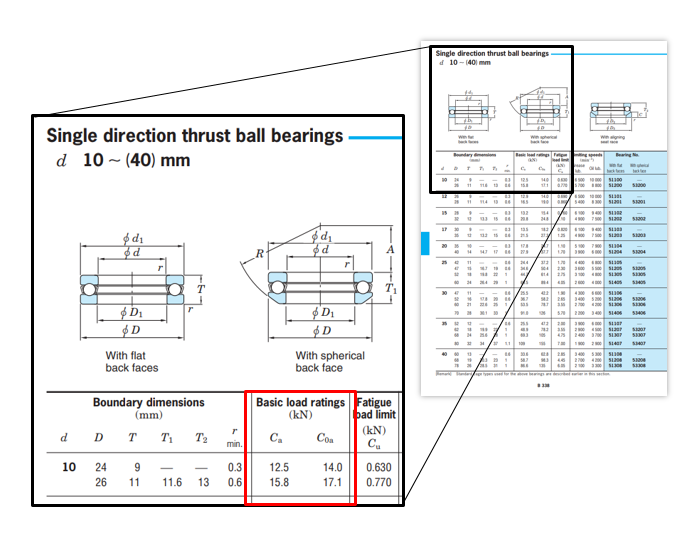
Fig. 10: Thrust bearings
Reference: Ball & Roller Bearings Catalog thrust ball bearing specifications table
3. Boundary dimensions and bearing numbers
If, after conducting the above procedure, the result of the procedure might not satisfy the application requirements and usage criteria of the machine in which it is to be used, use a bearing with different dimensions. In that case, you can find the other bearing (one with the appropriate dimensions) by using the boundary dimensions and bearing number.
1) Boundary dimensions
The boundary dimensions of the bearing are dimensions required for bearing installation with shaft and housing, include the bore diameter, outside diameter, width or height, and chamfer dimensions (see Figures 11 and 12). Our bearing catalog systematically shows the boundary dimensions for the bore diameter.
Reference: Boundary dimensions
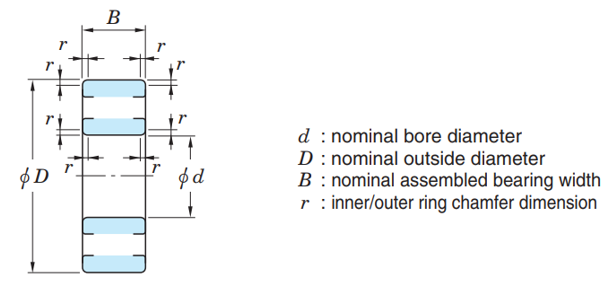
Fig. 11: The boundary dimensions of radial bearings
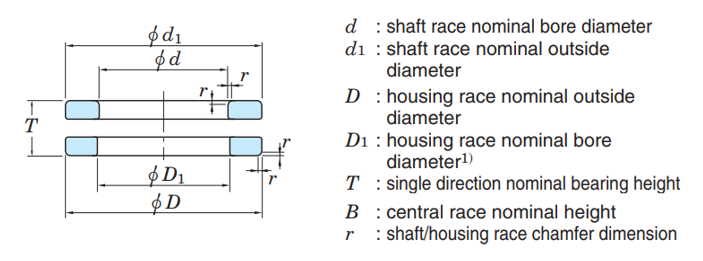
Fig. 12: The boundary dimensions of thrust bearings
2) Bearing number
The "bearing number" is a designation (number) that indicates special characteristics of a bearing.
This bearing number systematically indicates bearing specifications including bearing type, boundary dimensions, running accuracy, internal clearance, and so on. It allows us to easily select a bearing.
Most of bearing boundary dimensions of the bearing are in accordance with ISO standards, and the JIS, Japan Industrial Standards, also follows the ISO standards. For this reason, bearings can be considered an international commodity.
Typical examples of bearing numbers
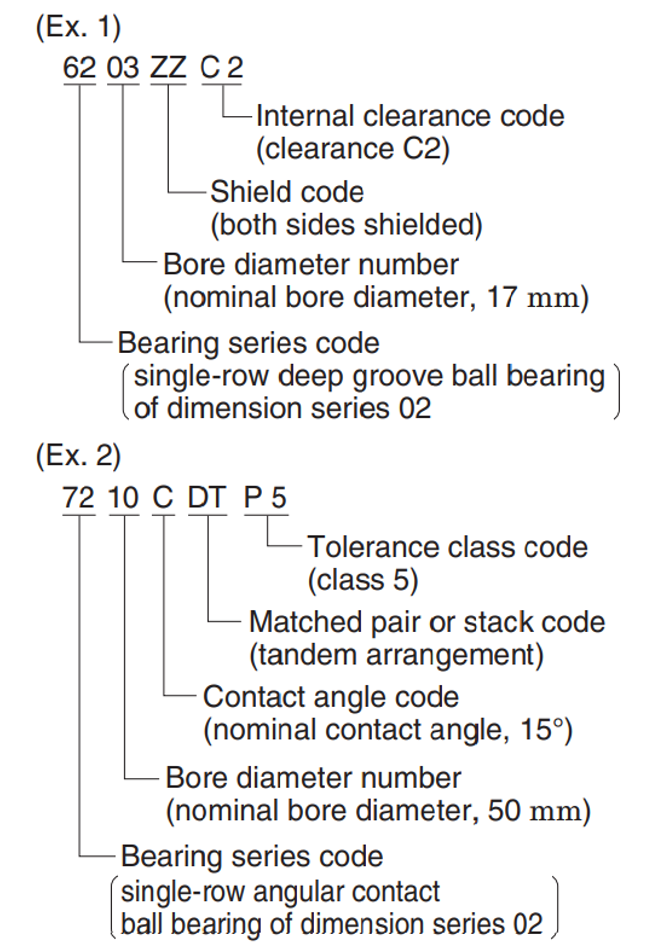
For more details, see:
Reference: Bearing series code
Reference: Bearing number configuration
4. Conclusion
In this part, we explained about the dimensions and service life of a bearing as measures for whether the bearing type you chose was appropriate.
- Set a bearing service life that satisfies the requirements of the machine application and usage criteria.
- Select a bearing with the basic dynamic load rating that satisfies that service life.
- Select a bearing with the basic static load rating that allows smooth rotation.
- Select a bearing with the appropriate boundary dimensions to satisfy these requirements.
This bearing number will allow you to easily select a bearing.
